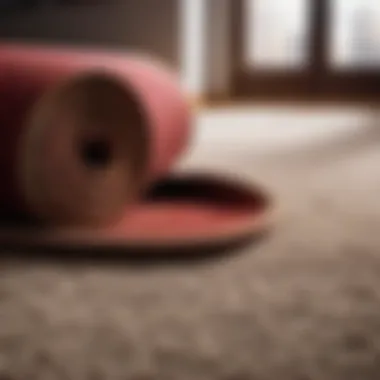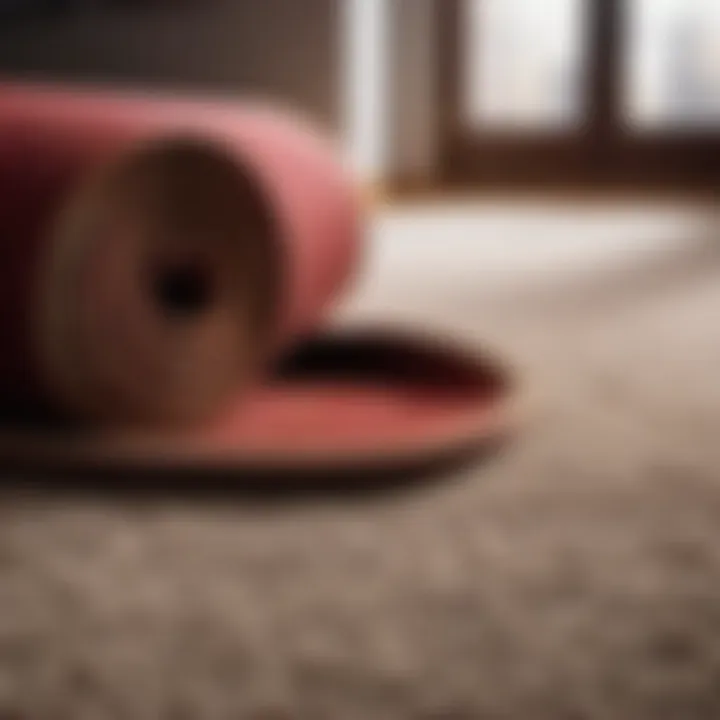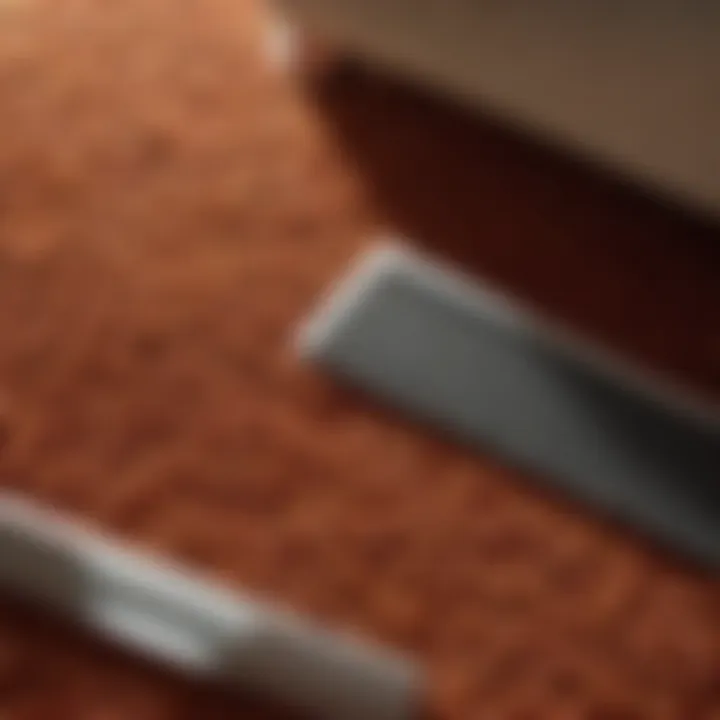Unveiling the True Expenses of Installing Bedroom Carpet


Materials:
The following is a comprehensive list of materials required for installing carpet in a bedroom:
- Carpet roll (specific size of your bedroom dimensions).
- Carpet padding (appropriate thickness recommended for comfort and durability).
- Carpet adhesive or double-sided carpet tape.
- Seam sealer (to seamlessly join carpet pieces if needed).
- Tack strips (to secure carpet edges).
- Knee kicker (for stretching carpet properly).
- Carpet stretcher (for larger rooms to ensure a smooth finish).
- Utility knife (for precise cutting of carpet).
- Measuring tape (to accurately measure room dimensions).
- Chalk line (to mark guidelines for straight cuts).
- Safety goggles and gloves (for personal protection).
DIY Steps:
To start the carpet installation process, follow these detailed steps:
- Prepare the Room: Remove all furniture and thoroughly clean the floor surface.
- Measure and Cut Materials: Measure the room dimensions carefully and cut the carpet and padding accordingly, leaving a bit extra for trimming.
- Lay Padding: Lay the carpet padding uniformly across the entire floor space.
- Install Tack Strips: Place tack strips along the edges of the room, ensuring they are secure for stretching the carpet.
- Fit the Carpet: Position the carpet over the padding, ensuring it aligns correctly with the walls.
- Stretch and Secure: Use a knee kicker and stretcher to stretch the carpet tightly and secure it onto the tack strips.
- Trim Excess: Trim any excess carpet using a utility knife for a neat finish.
Technical Aspects:
Ensure you have the following tools and adhere to these technical aspects:
- Ideal timing for installation is when there is optimal lighting for visibility.
- Maintain proper ventilation while using adhesive for safety.
- Use knee pads to protect knees during the carpet laying process.
- Double-check measurements before cutting materials to avoid wastage.
DIY Project Process:
Following a sequential approach is crucial for a successful carpet installation:
- Begin in one corner of the room and work towards the opposite corner to prevent stepping on fresh carpet.
- Always double-check the alignment and smoothness of the carpet as you progress.
- If any issues arise, such as wrinkles or unevenness, address them promptly to ensure a professional finish.
Troubleshooting Tips:
In case of common issues encountered during installation:
- Wrinkles: Use a knee kicker and stretcher to remove wrinkles by re-stretching the carpet.
- Poor Adhesion: Apply additional adhesive or tape in areas where the carpet is not sticking properly.
- Uneven Cuts: Use a straight edge guide when cutting carpet to ensure clean and straight edges.
Factors Affecting the Cost of Carpet Installation
When it comes to installing carpet in a bedroom, several key factors affect the overall cost. Understanding these factors is crucial for homeowners and housewives looking to embark on a carpet installation project. By delving into the specifics of each element influencing costs, individuals can make informed decisions that align with their budget and preferences.
Size of the Bedroom


In the realm of carpet installation expenses, the size of the bedroom plays a significant role. The square footage of the room directly impacts the amount of carpet needed, thereby influencing the total cost of the project. Larger rooms require more carpeting, resulting in higher material expenses and potentially increased labor costs.
Square footage considerations
The square footage of a bedroom is a critical factor to consider when estimating the cost of carpet installation. This measurement dictates the quantity of carpet required to cover the entire floor area effectively. Homeowners must accurately measure the room's dimensions to ensure they purchase the right amount of carpet without excess waste, optimizing cost-efficiency.
Type and Quality of Carpet
The type and quality of carpet selected for the bedroom also contribute significantly to the overall installation cost. Different carpet materials and variations come with varying price points, affecting the total expenses involved. Additionally, factors such as the pile height and density impact not only influence the aesthetic appeal but also the financial investment required.
Material variations
The choice of carpet material is a crucial decision that influences the cost and performance of the installation. Material variations range from polyester to wool, each with distinct advantages and disadvantages in terms of durability, comfort, and price. Homeowners must weigh these factors carefully to select a carpet that aligns with their budget and lifestyle preferences.
Pile height and density impact
Pile height and density impact are essential considerations when assessing carpet quality and cost. Higher pile carpets often come at a premium price due to their luxurious feel and appearance. However, these options may require additional maintenance and can be more susceptible to wear and tear over time. On the other hand, carpets with lower pile heights and higher density offer durability and cost-efficiency, making them ideal for long-term investment in bedroom flooring.
Additional Materials Needed
Apart from the carpet itself, installing carpet in a bedroom necessitates additional materials such as padding, adhesive, and transition strips. These components play a vital role in ensuring the successful and long-lasting installation of the carpet.
Padding, adhesive, transition strips
Padding serves as a cushioning layer between the carpet and the floor, enhancing comfort and extending the carpet's lifespan. Adhesive secures the carpet in place, preventing shifting or movement over time. Transition strips provide a seamless finish between different flooring surfaces in adjoining rooms, creating a cohesive look throughout the house. While these materials contribute to the overall cost, they are essential for a professionally executed carpet installation that prioritizes durability and aesthetics.
Labor Costs
In addition to material expenses, labor costs are a significant component of the total carpet installation budget. Professional installation fees encompass the skilled labor required to lay the carpet properly, ensuring a flawless finish that meets industry standards and homeowner expectations.
Professional installation fees
Professional installation fees reflect the cost of expertise and labor involved in transforming the bedroom with a new carpet. Skilled carpet installers possess the knowledge and tools necessary to handle the intricacies of carpet laying, including pattern alignment, seam concealment, and stretch-in techniques. While DIY installation may seem cost-effective, opting for professional services can guarantee a high-quality outcome and minimize the risk of errors that could lead to additional expenses down the line.
Calculating the Total Cost


When it comes to installing carpet in a bedroom, understanding the total cost involved is paramount. The calculation of the total cost encompasses various elements that play a crucial role in determining the overall expenses. By delving into the cost breakdown, individuals gain a comprehensive overview of what factors contribute to the final pricing. From the materials used to the labor fees incurred, calculating the total cost helps in setting a realistic budget and managing expectations effectively.
Cost of Carpet per Square Foot
Various price points
The cost of carpet per square foot is a pivotal aspect to consider when estimating the total expenses of carpet installation. Various price points exist within the market, allowing for flexibility in choosing a carpet that suits both budget constraints and quality requirements. Understanding the different price points enables individuals to make informed decisions based on their preferences and financial capabilities. Whether opting for a budget-friendly option or investing in a higher-end carpet, the variety in price points caters to a diverse range of needs and preferences.
Additional Costs
Padding expenses
Padding expenses are a crucial component to include in the overall cost assessment of carpet installation. The type and quality of padding chosen can significantly impact the comfort, durability, and aesthetics of the carpeted area. By investing in high-quality padding, individuals can enhance the longevity of their carpet and improve the overall insulation and cushioning of the floor. While padding expenses may add to the initial cost, they prove to be a worthwhile investment in the long run.
Labor charges
Labor charges constitute a significant portion of the total cost of carpet installation. Professional installation ensures that the carpet is laid out correctly, minimizing potential errors and ensuring a seamless finish. While labor charges may contribute to the overall expenses, the expertise and efficiency provided by professionals warrant the cost. By entrusting the installation to experienced professionals, individuals can avoid potential issues and achieve a high-quality end result.
Total Estimated Cost Range
Low, average, and high-end estimates
The total estimated cost range offers insight into the potential expenses individuals might incur during the carpet installation process. By providing low, average, and high-end estimates, individuals can gauge the financial implications of their carpet selection and installation choices. The range offers clarity on the varying costs associated with different material qualities, labor considerations, and additional expenses. Understanding the fluctuations within the cost range allows individuals to make informed decisions that align with their budget constraints and desired outcomes.
Cost Breakdown and Analysis
Breakdown of Material Costs
When it comes to the breakdown of material costs in carpet installation, considerations revolve around the types of materials required and their respective contributions to the overall project. Carpet, padding, and other necessary materials each play a vital role in determining the quality and durability of the final outcome. Carpet provides the aesthetic appeal and comfort underfoot, while padding acts as a foundation for the carpet, enhancing its lifespan and performance.
Carpet selection is critical as it determines the overall look and feel of the room. Factors such as material composition, pile height, and density impact the carpet's durability, maintenance requirements, and overall appearance. High-quality carpets may come at a higher price point but offer superior longevity and visual appeal, making them a wise investment in the long run.
Padding is often underestimated but essential for ensuring the carpet's longevity and providing additional comfort. The padding material and thickness can influence the carpet's feel and insulation properties. Opting for high-quality padding can enhance the carpet's performance and longevity, reducing the need for early replacements and maintenance costs. Other materials, such as adhesive and transition strips, are also crucial for a seamless and durable carpet installation.
Considering the advantages and disadvantages of each material component is essential in choosing the right mix for a cost-effective yet high-quality carpet installation. Investing in durable and suitable materials not only enhances the overall look and longevity of the carpet but also reduces future maintenance and replacement expenses, making it a financially prudent decision.


Labor Cost Analysis
Analyzing the labor costs associated with carpet installation is imperative for understanding the financial implications of the project. Hourly rates and total labor charges encompass the professional expertise and craftsmanship required to deliver a flawless and durable carpet installation. Labor costs contribute significantly to the overall budget, highlighting the value of expert installation services.
Hourly rates reflect the skill level and experience of the installers, directly impacting the quality of work and the final outcome. Experienced installers may charge higher rates but offer precision and efficiency in their work, ensuring a seamless and long-lasting carpet installation. Total labor charges cover the entire installation process, encompassing tasks such as preparation, installation, and cleanup.
The advantages of investing in professional labor for carpet installation include expertise, efficiency, and warranty coverage. Professional installers possess the skills and tools required for a successful installation, guaranteeing a superior finish and durability. While labor costs contribute to the overall expenses, the quality and reliability of professional installation justify the investment, ensuring a satisfactory and long-lasting result.
Comparative Pricing Insights
Exploring comparative pricing insights, particularly local market variations, provides valuable information for optimizing cost-efficiency in carpet installation projects. Understanding the pricing dynamics in the local market allows homeowners to compare quotes effectively and negotiate prices for the best deal. Local market variations impact material costs, labor charges, and overall project expenses, influencing the budgeting process.
Local market variations can stem from factors such as supply and demand trends, competition among providers, and regional economic conditions. By considering these insights, individuals can leverage competitive pricing offers, discounts, and promotions available in the local market. Comparative analysis enables homeowners to make informed decisions based on cost-effectiveness and quality, aligning the project's budget with their expectations.
By harnessing comparative pricing insights and researching local market variations, individuals can maximize cost savings without compromising on quality. Analyzing competitive pricing structures, service offerings, and reputation of providers allows for informed decision-making and budget optimization in carpet installation projects.
Tips for Cost-Effective Carpet Installation
When it comes to installing carpet in a bedroom, achieving a balance between quality and cost-efficiency is crucial. This section delves into essential tips for ensuring a cost-effective carpet installation process that doesn't compromise on results. From DIY options to negotiating pricing effectively and seeking multiple quotes, here are some key strategies to consider:
DIY vs. Professional Installation
Pros and Cons of Each Approach
Deciding between a DIY installation and hiring professionals involves weighing the advantages and disadvantages of each approach. For some homeowners, the idea of saving money by taking on the installation themselves can be appealing; however, it's essential to recognize the potential pitfalls of DIY carpet installation. On the other hand, professional installation offers expertise and a guarantee of quality work, but at a higher cost.
While DIY installation can provide a sense of accomplishment and potential cost savings, it requires skill, time, and the right tools. In contrast, professional installation ensures precision and efficiency, but at a premium price. Homeowners should carefully consider their level of experience, available time, and budget before making a decision.
Negotiating Pricing
Effective Negotiation Strategies
Negotiating pricing for carpet installation is a skill that can significantly impact the overall cost. Effective negotiation strategies can help homeowners secure competitive rates from carpet suppliers and installers. Whether it involves bargaining for discounts on materials or negotiating installation fees, knowing how to navigate pricing discussions is key.
One effective strategy is to gather quotes from multiple providers and leverage these competing offers to negotiate better deals. Additionally, being well-informed about market prices and understanding the scope of work required can give homeowners the upper hand in negotiations. By advocating for transparent pricing and asking questions about any additional charges, homeowners can ensure they receive a fair deal.
Seeking Multiple Quotes
Comparative Analysis Benefits
Seeking multiple quotes for carpet installation allows homeowners to compare prices, services, and quality offerings from various providers. This competitive analysis not only helps in identifying cost-effective options but also enables homeowners to make informed decisions based on value and expertise.
By soliciting quotes from different carpet suppliers and installers, homeowners can gain insights into market trends, pricing variations, and service packages. This comparative approach empowers homeowners to select a provider that aligns with their budget and expectations, ensuring a successful and cost-effective carpet installation project.







